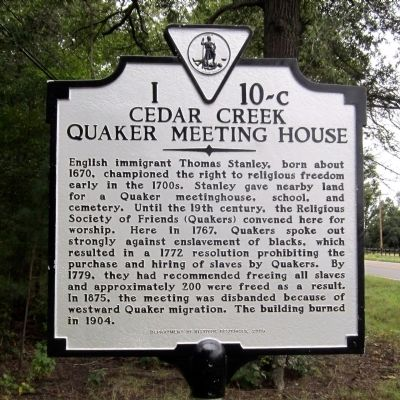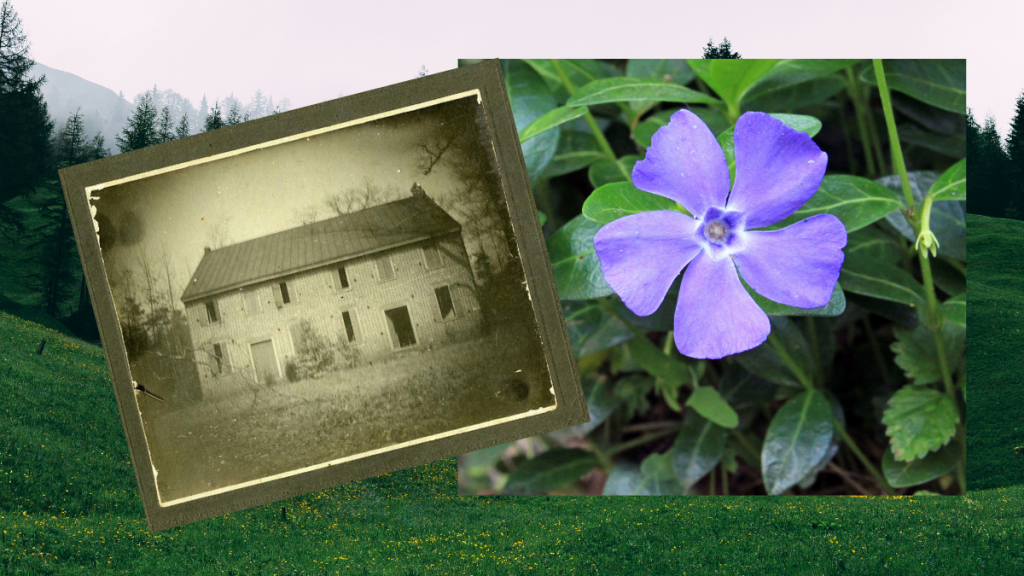Nestled on a wooded knoll surrounded by periwinkle lies the remains of a 300-year-old structure that once was the Cedar Creek Meeting House. Established in 1721 from land donated by Thomas Stanley, the site lies west of an old 18th-century roadbed in Hanover County, Virginia. The church site is now on an old, abandoned road just off Cedar Creek Road. The cemetery, filled with field stones, holds the remains of early congregation members. This article will recognize the early members by citing their names today. The original structure, constructed by John Saunders in 1739, remained in use until 1768. A new separate building measuring 30 feet by 24 feet replaced the older meeting house and was in use until 1797. The congregation decided to construct a brick building on the site with two front door entrances. This building stood until it burned in 1904. Ironically, the Richmond Times-Dispatch published a lengthy article about the history of the Cedar Creek Meeting House during the first week of April 1904. Two weeks later, on April 21, the 1797 building lay in ruins, succumbed to a wild brush fire.
Quaker records are fascinating to explore because they offer so much detail. Like the Moravians, the early Quaker documents reveal details about 18th-century family life that would otherwise never be known. The early Quaker cemeteries offer field stones as grave markers and lack the names and dates of the person. But, the 18th-century meeting house books make up for the missing information in the cemetery. An archaeological investigation of the original structure site seems to be ongoing per the Virginia Department of Historic Resources. Fragments of the past are uncovered on the wooded knoll just east of Cedar Creek. Most churches would plan the cemetery and line the graves in rows. The Quakers are known for their disciplined simplicity, which would carry over with funerals of the period. Before burial, a brief prayer, a silent moment, and a short reading from the scriptures would be the funeral service. After conducting this study on Cedar Creek, the plans for the original cemetery have not surfaced yet. But, hopefully, in the future, we will all learn more about the people buried at Cedar Creek Meeting House.

This historic road marker is located 1 mile west of the original site. Photo courtesy of Bernhard Fisher, 2011 (https://www.hmdb.org/m.asp?m=47374)
The Quaker members of Cedar Creek grew during the years preceding the American Revolutionary War. During the large meetings, the data records hundreds in attendance for church services. The exact number of interments is unknown for the adjacent cemetery, but one can estimate over fifty as an approximate calculation. The Reverends also kept personal journals and records, which give explicit clues and even more information. Nathaniel Crenshaw, John Crenshaw, Edward Mosby, and John Harris are a few of the most significant leaders of Cedar Creek Meeting House.
The Cedar Creek Monthly Meeting House changed its name in 1874 to the Richmond Monthly Meeting House. Meetings held from that period show a substantial decline in attendance, and by 1894, the building was vacant and silent. Many original congregation members migrated south to the Carolinas or west to Tennessee and Kentucky during the mid-18th-century. We have preserved the early surnames from Cedar Creek in an alphabetical list found below.
Cedar Creek Meeting House Surnames 1721-1770
- Anthony, Joseph
- Ballard, Byrom
- Ballard, William
- Barksdale
- Bates, Benjamin
- Bell, George
- Blossom, Richard
- Bloxom, Richard
- Bunch, John
- Candler, John
- Cheadle
- Chiles, Menoah
- Clark, Boling
- Clark, Francis
- Clark, John
- Clark, Micajah
- Cobbs, Pleasant
- Couch, Samuel
- Cowgill, James
- Crawford, Peter
- Crew, James
- Crew, Joseph
- Crew, Littlebury
- Crew, Micah
- Davis, Micajah
- Douglas, John
- Douglas, Robert
- Easton, Charles
- Farish, Robert
- Garland, David
- Hargrave, Joseph
- Hargrave, Samuel
- Hargrave, Thomas
- Harris, Benjamin
- Harris, Jeremiah
- Harris, Daniel
- Harris, Moses
- Harris, Thomas
- Hart, Henry Phillips
- Hatton, Thomas
- Hunnicutt, James
- Hutchins, John
- Johnson, Ashley
- Johnson, Benjamin
- Johnson, Gerard
- Johnson, Jesse
- Johnson, John
- Johnson, Robert
- Johnson, William
- Jones, Catlet
- Ladd
- Lewis, Richard
- Mackgee
- Maddox, John Wilson
- Maddox, Nelson
- McGeehee,
- Moorman, Charles
- Moorman, Thomas
- Peatross, John
- Piller
- Pleasants, William Henry
- Ratcliff, William
- Snowden, Thomas
- Stabler, William
- Stanley, Achilles
- Stanley, Isaac
- Stanley, James
- Stanley, Littlebury
- Stanley, Maddox
- Stanley, Moses
- Stanley, Thomas
- Stanley, William
- Stanley, Zachariah
- Terrell, David
- Terrell, Henry
- Terrell, Jesse
- Terrell, Jonathan
- Terrell, Matthew
- Terrell, Pleasant
- Terrell, Thomas
- Terrell, Timothy
- Vaughan, Benjamin
- Watkins, Benjamin
- Winston, George
- Winston, Nathaniel
- Woodson, Joseph

The photo of the Cedar Creek Meeting House is provided by the Quaker Archives Guilford College in North Carolina: FMCedaCr-0000-01-150-Flickr published 2011-https://live.staticflickr.com/8327/8405773264_88691537cf_c.jpg The added material is under the license of Canva.
The location of this Quaker meeting house offers the perfect elements of the colonial Virginia landscape. The area sits tranquil, embraced by the nearby creek spanning the width of 5 to 6 feet to its banks. In the past, a small bridge crossed here at Cedar Creek along the old road to the Meeting House. After crossing the creek, you hike up the hill approximately 75 feet to the knoll filled with periwinkle and the site of the original meeting house. The cemetery is to your right as you gaze upon the ground depressions in the earth marking each grave. Brick remnants and field stones remind us that hundreds gathered in this spot to relish in their beliefs with their friends.
Quaker Genealogy: Cedar Creek, Virginia – Piedmont Trails
Sources:
- Harold I. Meyer. “Cedar Creek Meeting House, Hanover County, Virginia.” The Virginia Magazine of History and Biography, vol. 64, no. 4, 1956, pp. 454–57, http://www.jstor.org/stable/4246250. Accessed 16 May 2022.
- Cedar Creek Meeting Minutes Manuscripts from State Library of Virginia, Richmond
- Brown, Douglas, Cedar Creek Monthly Meeting and Its Meeting House. William and Mary, Quarterly XIX (Series 2) p. 293-298.
- Richmond Times-Dispatch Newspaper dated April 1904
- Brewer, Mary Marshall “Quaker Records of Cedar Creek Monthly Meeting Virginia 1739-1793” Heritage Books, Inc. Maryland, 2019
- Rowland, Isaiah map of 1757 showing Quaker Meeting Houses, Rivers and Roads in Virginia
- Virginia Department of Historic Resources- Division of State Archaeology
- Jones, Rufus Matthews “The Quakers In The American Colonies” Russell & Russell, New York, 1962
- Bell, James Pinkey Pleasant “Our Quaker Friends of Ye Olden Time” J.P. Bell Co. Lynchburg, Virginia 1905
Views: 274
Comment
© 2024 Created by IIGSExecDirector.
Powered by
![]()
You need to be a member of Genealogy Wise to add comments!
Join Genealogy Wise